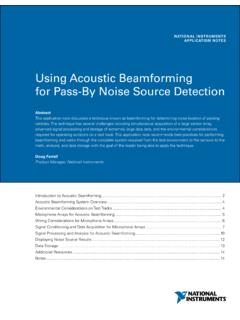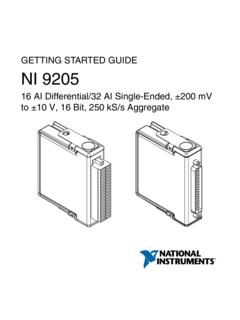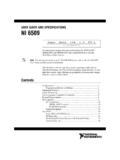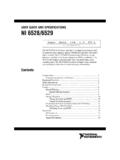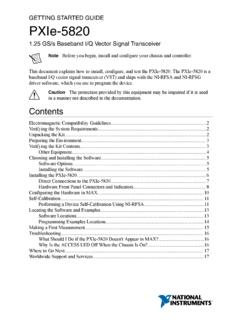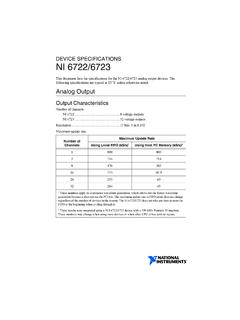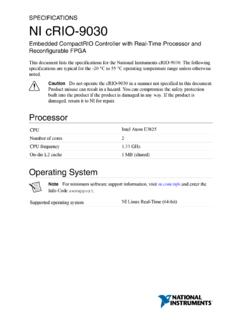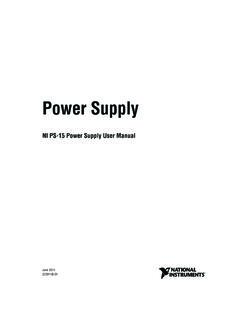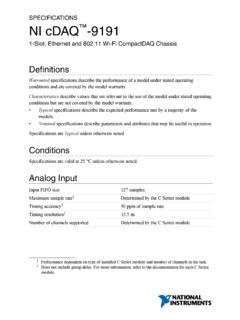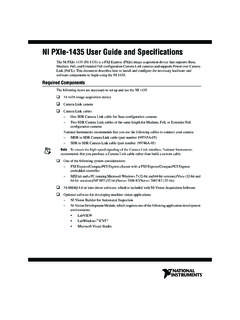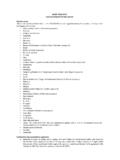Transcription of Archived: LabVIEW User Manual - National Instruments
1 user ManualLabVIEW user ManualJanuary 1998 EditionPart Number 320999B-01 Internet SupportE-mail: Site: Address: Board SupportBBS United States: 512 794 5422 BBS United Kingdom: 01635 551422 BBS France: 01 48 65 15 59 Fax-on-Demand Support512 418 1111 Telephone Support (USA)Tel: 512 795 8248 Fax: 512 794 5678 International OfficesAustralia 03 9879 5166, Austria 0662 45 79 90 0, Belgium 02 757 00 20, Brazil 011 288 3336, Canada (Ontario) 905 785 0085, Canada (Qu bec) 514 694 8521, Denmark 45 76 26 00, Finland 09 725 725 11, France 01 48 14 24 24, Germany 089 741 31 30, Hong Kong 2645 3186, Israel 03 6120092, Italy 02 413091, Japan 03 5472 2970, Korea 02 596 7456, Mexico 5 520 2635, Netherlands 0348 433466, Norway 32 84 84 00, Singapore 2265886, Spain 91 640 0085, Sweden 08 730 49 70, Switzerland 056 200 51 51, Taiwan 02 377 1200, United Kingdom 01635 523545 National Instruments Corporate Headquarters6504 Bridge Point ParkwayAustin, Texas 78730-5039 USATel: 512 794 0100 Copyright 1992, 1998 National Instruments Corporation.
2 All rights reserved. Important InformationWarrantyThe media on which you receive National Instruments software are warranted not to fail to execute programming instructions, due to defects in materials and workmanship, for a period of 90 days from date of shipment, as evidenced by receipts or other documentation. National Instruments will, at its option, repair or replace software media that do not execute programming instructions if National Instruments receives notice of such defects during the warranty period. National Instruments does not warrant that the operation of the software shall be uninterrupted or error Return Material Authorization (RMA) number must be obtained from the factory and clearly marked on the outside of the package before any equipment will be accepted for warranty work. National Instruments will pay the shipping costs of returning to the owner parts which are covered by Instruments believes that the information in this Manual is accurate. The document has been carefully reviewed for technical accuracy.
3 In the event that technical or typographical errors exist, National Instruments reserves the right to make changes to subsequent editions of this document without prior notice to holders of this edition. The reader should consult National Instruments if errors are suspected. In no event shall National Instruments be liable for any damages arising out of or related to this document or the information contained in AS SPECIFIED HEREIN, National Instruments MAKES NO WARRANTIES, EXPRESS OR IMPLIED, AND SPECIFICALLY DISCLAIMS ANY WARRANTY OF MERCHANTABILITY OR FITNESS FOR A PARTICULAR PURPOSE. CUSTOMER S RIGHT TO RECOVER DAMAGES CAUSED BY FAULT OR NEGLIGENCE ON THE PART OF National Instruments SHALL BE LIMITED TO THE AMOUNT THERETOFORE PAID BY THE CUSTOMER. National Instruments WILL NOT BE LIABLE FOR DAMAGES RESULTING FROM LOSS OF DATA, PROFITS, USE OF PRODUCTS, OR INCIDENTAL OR CONSEQUENTIAL DAMAGES, EVEN IF ADVISED OF THE POSSIBILITY THEREOF. This limitation of the liability of National Instruments will apply regardless of the form of action, whether in contract or tort, including negligence.
4 Any action against National Instruments must be brought within one year after the cause of action accrues. National Instruments shall not be liable for any delay in performance due to causes beyond its reasonable control. The warranty provided herein does not cover damages, defects, malfunctions, or service failures caused by owner s failure to follow the National Instruments installation, operation, or maintenance instructions; owner s modification of the product; owner s abuse, misuse, or negligent acts; and power failure or surges, fire, flood, accident, actions of third parties, or other events outside reasonable the copyright laws, this publication may not be reproduced or transmitted in any form, electronic or mechanical, including photocopying, recording, storing in an information retrieval system, or translating, in whole or in part, without the prior written consent of National Instruments , LabVIEW , National Instruments , , NI-488 , , NI-DAQ , NI-VISA , NI-VXI , SCXI , and VXIpc , are trademarks of National Instruments and company names listed are trademarks or trade names of their respective REGARDING MEDICAL AND CLINICAL USE OF National Instruments PRODUCTSN ational Instruments products are not designed with components and testing intended to ensure a level of reliability suitable for use in treatment and diagnosis of humans.
5 Applications of National Instruments products involving medical or clinical treatment can create a potential for accidental injury caused by product failure, or by errors on the part of the user or application designer. Any use or application of National Instruments products for or involving medical or clinical treatment must be performed by properly trained and qualified medical personnel, and all traditional medical safeguards, equipment, and procedures that are appropriate in the particular situation to prevent serious injury or death should always continue to be used when National Instruments products are being used. National Instruments products are NOT intended to be a substitute for any form of established process, procedure, or equipment used to monitor or safeguard human health and safety in medical or clinical treatment. National Instruments CorporationvLabVIEW user ManualContentsAbout This ManualOrganization of This Manual .. xxiiiPart I, Introduction to G xxiiiPart II, I/O Interfaces.
6 XxivPart III, xxivPart IV, Network and Interapplication xxvPart V, Advanced G xxviAppendices, Glossary, and Index .. xxviConventions Used in This xxviiRelated xxviiiCustomer Communication .. xxviiiChapter 1 IntroductionWhat Is LabVIEW ? .. 1-1 How Does LabVIEW Work? .. 1-1G Programming .. 1-2 Organization of the LabVIEW System (Windows) .. 1-4 Startup Screen on Windows .. 1-5 Organization of the LabVIEW System (Macintosh) .. 1-6 Organization of the LabVIEW System (UNIX) .. 1-7 Toolkit Support ..1-9 Where Should I Start? .. 1-9 PART IIntroduction to G ProgrammingChapter 2 Creating VIsWhat is a Virtual Instrument? .. 2-1 How Do You Build a VI? .. 2-1VI Hierarchy .. 2-1 Controls, Constants, and 2-2 Terminals .. 2-3 ContentsLabVIEW user Manualvi National Instruments CorporationWires .. 2-4 Tip Strips .. 2-4 Wire Stretching .. 2-5 Selecting and Deleting Wires .. 2-5 Bad Wires .. 2-6VI Documentation .. 2-10 What is a SubVI?.. 2-12 Hierarchy Window .. 2-12 Search Hierarchy.
7 2-14 Icon and Connector .. 2-14 Opening, Operating, and Changing 2-19 Front Panel .. 2-19 Block Diagram .. 2-20 How Do You Debug a VI? .. 2-21 Chapter 3 Loops and ChartsWhat is a Structure?.. 3-2 Chart Modes .. 3-2 Faster Chart Updates .. 3-3 Overlaid Versus Stacked Plots .. 3-3 While Loops ..3-4 Front Panel .. 3-5 Block Diagram .. 3-6 Mechanical Action of Boolean Switches .. 3-8 Timing .. 3-10 Preventing Code Execution in the First Iteration .. 3-12 Shift Registers ..3-13 Front Panel .. 3-15 Block Diagram .. 3-15 Using Uninitialized Shift 3-17 Front Panel .. 3-19 Block Diagram .. 3-20 For 3-22 Numeric Conversion .. 3-24 Front Panel .. 3-25 Block Diagram .. 3-26 Contents National Instruments CorporationviiLabVIEW user ManualChapter 4 Case and Sequence Structures and the Formula NodeCase Structure ..4-2 Front 4-2 Block 4-3VI 4-4 Sequence Structures .. 4-5 Front 4-5 Modifying the Numeric Format .. 4-6 Setting the Data 4-7 Block 4-7 Formula Node .. 4-11 Front 4-14 Block 4-14 Artificial Data Dependency.
8 4-15 Chapter 5 Arrays, Clusters, and 5-1 How Do You Create and Initialize Arrays? .. 5-1 Array Controls, Constants, and Indicators .. 5-2 Front 5-3 Block 5-4 Multiplot Graphs .. 5-7 Using Auto-Indexing to Set the For Loop Count .. 5-10 Using Array Functions .. 5-10 Build Array .. 5-10 Initialize Array .. 5-11 Array Size .. 5-12 Array 5-13 Index Array .. 5-14 Front 5-17 Block 5-18 Efficient Memory Usage: Minimizing Data 5-18 What is Polymorphism?.. 5-19 Clusters .. 5-20 ContentsLabVIEW user Manualviii National Instruments 5-20 Customizing 5-20 Graph Cursors .. 5-21 Graph Axes .. 5-22 Data Acquisition 5-22 Front Panel .. 5-22 Block Diagram .. 5-23 Intensity Plots .. 5-25 Chapter 6 Strings and File 6-1 Creating String Controls and 6-1 Strings and File I/O .. 6-2 Front Panel .. 6-2 Block Diagram .. 6-3 Front Panel .. 6-4 Block Diagram .. 6-4 Front Panel .. 6-7 Block Diagram .. 6-8 File 6-9 File I/O Functions .. 6-9 Writing to a Spreadsheet File.
9 6-11 Front Panel .. 6-12 Block Diagram .. 6-12 Front Panel .. 6-14 Block Diagram .. 6-15 Front Panel .. 6-16 Block Diagram .. 6-17 Using the File I/O Functions .. 6-18 Specifying a File .. 6-18 Paths and Refnums .. 6-19 File I/O Examples .. 6-19 Datalog 6-20 Contents National Instruments CorporationixLabVIEW user ManualPART III/O InterfacesChapter 7 Getting Started with a LabVIEW Instrument DriverWhat is a LabVIEW Instrument Driver? .. 7-1 Where Can I Get Instrument Drivers? .. 7-2 Where Should I Install My LabVIEW Instrument Driver? .. 7-2 How Do I Access the Instrument Driver VIs? .. 7-3 Instrument Driver Structure .. 7-4 Obtaining Help for Your Instrument Driver VIs .. 7-6 Running the Getting Started VI Interactively (Selecting the GPIB Address, Serial Port, and Logical Address) .. 7-7 Interactively Testing Component VIs .. 7-8 Building Your Application .. 7-9 Related Topics ..7-10 Open VISA Session Monitor 7-10 Error 7-11 Testing Communication with Your 7-11 Developing a Quick and Simple LabVIEW Instrument 7-12 Modifying an Existing Driver.
10 7-12 Developing a Simple Driver .. 7-13 Developing a Full-Featured Driver .. 7-17 Using LabVIEW with IVI Instrument Drivers .. 7-17 Chapter 8 LabVIEW VISA TutorialWhat is VISA? .. 8-1 Supported Platforms and Environments .. 8-1 Why Use VISA? .. 8-2 VISA Is the 8-2 Interface 8-2 Platform Independence .. 8-2 Easily Adapted to the Future .. 8-2 Basic VISA Concepts .. 8-3 Default Resource Manager, Session, and Instrument Descriptors .. 8-3 How Do I Search for Resources? .. 8-4 What is a VISA Class? .. 8-5 Popping Up on a VISA Control .. 8-6 Opening a Session .. 8-6 ContentsLabVIEW user Manualx National Instruments CorporationHow Do the Default Resource Manager, Instrument Descriptors, and Sessions Relate? .. 8-7 Closing a Session .. 8-8 When Is It a Good Idea to Leave a Session Open?.. 8-8 Error Handling with VISA .. 8-9 Easy VISA VIs .. 8-11 Message-Based Communication .. 8-11 How Do I Write To and Read From a Message-Based Device? .. 8-12 Register-Based Communication (VXI only).
